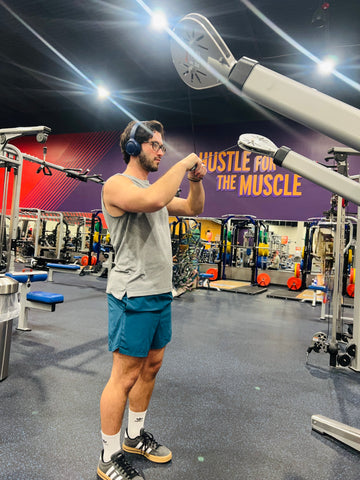
Ever put on a suit jacket and realize it doesn't fit anymore?
It sucks, right?
But hang on.
What if the reason for it not fitting was NOT because of your belly–but because of your shoulders?!
Now, we’re talking.
What if your shoulders gained so much muscle, that you couldn’t fit into your suit jacket anymore? So, while you may need to mourn the loss of your favorite suit jacket, you can celebrate all those shoulder gains from your hard work at the gym!
That happened to me, and one of the exercises that got me there was the rear delt cable fly! This is a great exercise that works your rear deltoid muscles–the muscles in the back of your shoulders.
So, if you want shoulders that pull at the seams of your old suit jacket–read on.
Today, we’ll unlock the secrets of how YOU can get explosive shoulder gains with the rear delt cable fly!
Along the way, I’ll also talk about:
- Rear Delt Cable Fly How To
- Rear Delt Cable Fly Pro Tips
- Best Rear Delt Cable Fly Variation
- Best Rear Delt Cable Fly Alternative
- Rear Delt Cable Fly Muscles Worked
- Rear Delt Cable Fly Benefits
At Back Muscle Solutions, we understand how strong, functional muscles are essential to your overall fitness journey—whether it’s building a balanced physique or managing chronic pain. Our mission is simple: we aim to help you unlock peak performance with expert advice on exercises, muscle care, and recovery. Today, our focus is all about those shoulder muscles. Let's get started.
Rear Delt Cable Fly: How To
Let’s not waste your time.
Before we get into the nitty-gritty of WHY it works: first, you need to know the basics.
How do you perform a rear delt cable fly?
Easy.
1) First, find a dual cable machine at your local gym.
2) Attach a set of D-handles to both sides of the dual cable machine.
3) For a regular rear delt cable fly, you’ll need a high cable. Set each cable to the same height as your head.
4) Cross your arms, grabbing the opposite D-handle with the hand on the other side. Hold your arms in this position with your hands in front of your face.
5) Take about two steps back. Hinge back at your hips slightly to enhance stability.


6) Retract your shoulder blades, and keep them in this position throughout the movement.
7) Pull the weight across your body, opening up your arms out and slightly downward. Each arm should form a 45-degree angle with your body. Keep a slight bend in your elbows.
8) Pause briefly. Then, return to the starting position, and repeat.

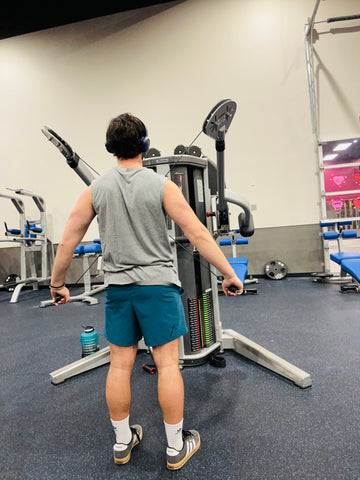
Trust me: The rear delt cable fly is NOT a hard exercise to master. All the same, it pays to know some pro tips to pay attention to during the motion.
Pro Tips: Look Like a Boss While You Do the Rear Delt Cable Fly
There aren’t a ton of exercises out there focused on hitting just your rear deltoids. Because this is such a specific muscle to hit, paying attention to these pro tips can help you make sure you ACTUALLY work your rear delts and not some other muscle trying to take all the attention.
Rear Delt Cable Fly Pro Tip #1: If You Strike Out on the Dual Cable Machine
Honestly, one of the toughest parts about this exercise is that you need to find a dual cable machine that has BOTH cables open, so you can set the high cables up on either side.
Depending on your gym, this could be a difficult ask. If your gym is super busy, you can definitely try the rear delt cable fly variation or alternative I talk about later in this article.
Rear Delt Cable Fly Pro Tip #2: Keep the Cables Up By Your Face
When you return to the starting position, the cables need to be up in front of your face–NOT down by your chest. Many people tend to naturally lower the cables as they get into the flow of the exercise, but this will actually target your lats instead of your shoulders/delts.
Rear Delt Cable Fly Pro Tip #3: Alternate Which Arm Is On Top
To make sure you’re getting equal muscle work for EACH arm, you can focus on switching which arm is on top for each rep. If this gets too hard to focus on, don't worry about it, but this can be a great way to level up the move when you’re ready!
Rear Delt Cable Fly Pro Tip #4: Keep the Weight Lighter
You can definitely challenge yourself on the weight here, but you’re not trying to overload it to the point where you compromise your form.
You DO want a slight bend in the elbows, but for the rear delt cable fly, you should move your ENTIRE ARM at the same time.
What happens when you overload the weight is that you tend to just hinge your arms at the elbows to compensate. This results in a great tricep workout, but it won’t get you those bulked-up shoulders you want!
Rear Delt Cable Fly Pro Tip #5: Picture Trying to Touch Your Hands Together Behind Your Back
Picturing this throughout the movement of the rear delt cable fly can help you ensure you are moving your entire arm together.
You won’t actually touch your hands together. This won’t be possible with this movement, but it can really help you maintain that form and place the emphasis on your shoulder muscles.
Rear Delt Cable Fly Pro Tip #6: Keep your Wrists Straight
Don’t bend your wrists throughout the motion. This might be easy to do, but keeping your wrists straight and in line with your arms throughout the motion will help your form.
Rear Delt Cable Fly Pro Tip #7: Choose Your Handles
Some people prefer D-handles, which I recommend above. But personally, I find the rear delt cable fly to be easier with no handles at all–just using the ball on the end of the cable.
Best Cable Rear Delt Variation: Single-Arm Rear Delt Cable Fly
The unilateral version of this exercise is the single-arm rear delt cable fly.
Some people prefer this move because it works better for isolation and ensures that one of your rear delts isn’t stronger than the other one.
Performing a single-arm rear delt cable fly is similar to a regular rear delt cable fly:
1) Set up the cable machine to a high cable–about head height.
2) Use a D-handle or you can go no-handles style.
3) Start with your less-dominant arm. Since this tends to be the weaker arm, this can help you tell what your max amount of reps is. (You don’t want to go higher in one arm!)
4) Grip the cable with that arm.
5) Pull the cable across your body, forming a 45-degree angle with your body at the end of the motion
6) Pause briefly. Then, slowly return to the starting position.
7) When you're done with that set, switch to your dominant arm!
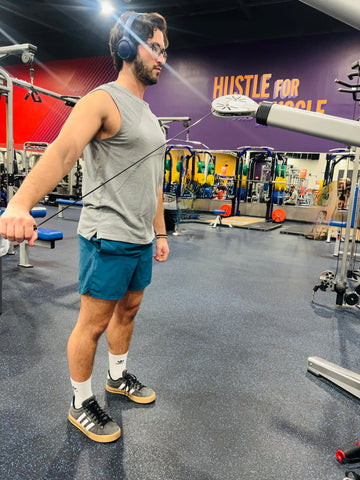
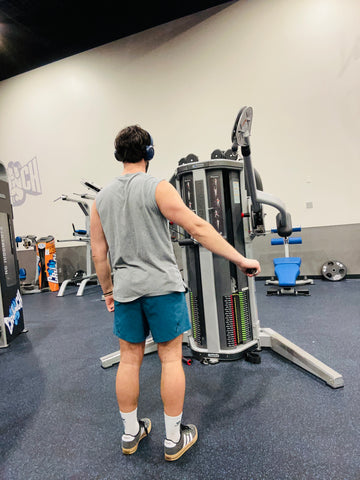
Best Cable Rear Delt Alternative: Reverse Pec Deck Fly
If two high cables are not available at the dual cable machine–and you want to still work BOTH arms instead of the single-arm rear delt cable fly, I recommend the reverse pec deck fly.
Compared to other exercises–such as the single-arm dumbbell row, shrug, upright row, and lateral raise–the reverse fly leads to some of the highest rear delt activations you can get. [1]
For this exercise, you’ll need to find a pec deck machine at your local gym. Here’s how to perform this rear delt cable fly alternative:
1) Face the pec deck machine, sitting on the machine with your chest against the pad.
2) Grab the handles with a neutral grip. This grip helps ensure you light up those rear delts! [1]
3) Extend your arms out, keeping your elbows slightly bent, and bringing your shoulder blades together.
4) Pause. Then, slowly return to the starting position, and repeat.


Rear Delt Cable Fly: Muscles Worked
Altogether, the rear delt cable fly works more muscles in addition to the delts, such as your:
- Traps
- Triceps
- Rotator Cuff
That’s some good bang for your buck if you ask me.
But let’s focus on what we’re all really here for. The rear delts.
What are delts, anyway?
What Are Rear Delts?
Also called the posterior deltoid, the rear deltoid–or rear delt for short–is one of three shoulder muscles.
- Anterior deltoids (Front delts)
- Lateral deltoids (Middle delts)
- Posterior deltoids (Rear delts)
It’s often the rear delts that tend to get worked the least, which is what makes the rear delt cable fly so special!
Honestly, these three deltoid muscles work together pretty well, but if we’re JUST focusing on the rear delt, here are its unique roles.
- Shoulder extension: moving your arm behind you. Think about putting your wallet in your back pocket.
- Shoulder external rotation: rotating your arm away from your body
Rear Delt Cable Fly: Benefits
Just because rear delts tend to get ignored doesn’t mean YOURS have to be!
There are loads of benefits that happen when you add cable rear delt exercises in to your workout routine and light up those rear delts!
Better Posture
Good posture starts with not being too “hunchy.”
Rear delt cable flyes address exactly that. They pull your shoulders DOWN and BACK–helping you puff out your chest and stand tall.
Good Upper Body Aesthetics
You can't just work out your front and middle delts if you want shoulders that are literally well-rounded. Your rear delts need a place in your workout routine in order for your shoulders to get an overall well-rounded exercise.
The end result? Your shoulders are muscular, bulkier, broader. Outgrowing those old clothes. What’s not to like about that?
Less Lower Back Strain
The rear delt cable fly is an exercise that–while targeting a specific muscle and helping you bulk it up–puts VERY LITTLE strain on your lower back.
This is an ideal exercise for someone struggling with lower back pain. You still deserve gains even if your lower back is giving you issues.
Lower Back Support - Stay Fit AND Keep Your Lower Back Safe
If your lower back IS causing you to slow your roll when it comes to your muscle gains, it’s worth addressing.
Our mission is to provide THE BEST lower back pain resources in the world for people who are tired of low back pain dictating their lives.
We believe that lower back pain shouldn’t stop you from:
- Enjoying your life!
- Staying fit
- Gaining muscle
So, how can we help YOU on your fitness journey?
More Articles on Shoulder Workouts
Ready to outgrow your old suit jackets?
Get well-rounded “boulder shoulders” when you combine what we learned today with these other articles on shoulder workouts.
“What are Shoulder Shrugs: Muscles Worked and Why You Should Build Them”
“Unleash Shoulders of Steel With the Face Pull: Muscles Worked & Variations”
Back of Steel: Lower Back Strengthening Program

Chances are–if your lower back is causing you grief during a workout, you might need to slow down and strengthen your lower back...of course, so you can get back to lifting heavy ASAP.
We’ve designed an exercise program specifically structured to address lower back weakness that can tend to cause overall pain in your lower back.
Back of Steel is a 15-minute-a-day/3-day-per-week program that you can complete independently from your own home. And with this program, you can take the guesswork out of which moves will help OR harm your lower back–letting us guide you through the best exercises to build you an ironclad lower back!
The QL Claw
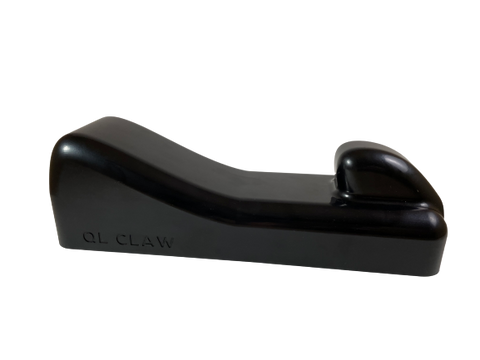
Interested in the device that started it all for us?
All the great resources we provide: the articles, the videos, the exercise programs–stem from this: The QL Claw.
It’s the at-home massage device that changed it all for us! Our founder, Ben, made this device after years of wrestling against his own back pain.
The QL Claw is designed to hit all 5 muscles that tend to defer pain to the lower back. Because we believe if you fix the muscles, you fix the pain!
The best parts about it?
- It’s portable: Use it at home or bring it to the gym!
- It’s easy: You literally just have to lie down on it to feel improvement from your lower back pain.
Check out what people have been saying about the Claw:


Shop The QL Claw below.
Rear Delt Cable Fly: FAQs
What is the best angle for cable rear delt flyes?
The best angle for cable rear delt flyes is if you keep your arms at a 45-degree angle from your body as you pull the cables down. This helps activate your rear delts.
Are rear delt flyes effective?
Cable rear delt flyes are incredibly effective at activating your rear delt, which is a muscle that can be hard to target.
Do cable flyes work deltoids?
Rear delt cable flyes work your rear deltoids as well as your traps, rhomboids, triceps, and rotator cuffs.
Why do I feel a rear delt cable fly in my tricep?
You’ll feel your triceps during a rear delt cable fly because this exercise is supposed to hit your triceps.
BUT be careful: If you load it up with too much weight, this will cause you to bend your elbows too much during the exercise–targeting JUST your triceps and not your rear delts.
Now that you've read about rear delt cable fly, check out our page on the cable Y raise!
[1] Schoenfeld, Brad1; Sonmez, R. Gul Tiryaki1; Kolber, Morey J.2; Contreras, Bret3; Harris, Robert1; Ozen, Serife4. Effect of Hand Position on EMG Activity of the Posterior Shoulder Musculature During a Horizontal Abduction Exercise. Journal of Strength and Conditioning Research 27(10):p 2644-2649, October 2013. | DOI: 10.1519/JSC.0b013e318281e1e9
[2] Elzanie A, Varacallo M. Anatomy, Shoulder and Upper Limb, Deltoid Muscle. In: StatPearls. StatPearls Publishing, Treasure Island (FL); 2023. PMID: 30725741.
[3] Morgan, Steven J MD; Furry, Kim MD; Parekh, Anand A MRCS (Eng); Agudelo, Juan F MD; Smith, Wade R MD. The Deltoid Muscle: An Anatomic Description of the Deltoid Insertion to the Proximal Humerus. Journal of Orthopaedic Trauma 20(1):p 19-21, January 2006. | DOI: 10.1097/01.bot.0000187063.43267.18


